This essay, Breastfeeding Bonding Prevents Infant Mortality and Suicide,
along with two accompanying videos provide dramatic information on the complex origins of violence in human cultures throughout the world.
This summary of a wide body of research spanning over 50 years, challenges thousands of years of child rearing practices of the dominant patristic/theistic cultures of the world and explains why those cultures appear unwilling to change, thus perpetuating the violence inherent in those cultures, which now represent the dominate cultures through the wor
The contemporary sexual violence in the U.S, military mirrors the culture from which it is drawn and changes in the military without changes in the culture are doomed to failure.
Changing culture means changing the brain that supports violent behavior in contrast to a brain that supports, peaceful, harmonious, egalitarian behaviors. The brain is the organ of behavior, as the film documentary supports. Pain inhibits Neurointegrative Pleasure and Peaceful, Harmonious and Egalitarian relationships; Neurointegrative Pleasure inhibits Pain and Violence
BASIC NEURAL NETWORKS OF THE BRAIN ARE FORMED DURING THE FIRST 3 YEARS OF LIFE.
The data presented herein demands the role of embodied Pleasure in human relationships, which is first learned at the breast of Mother—the primary agent of Nurturance, which prevents depression and violence. Disembodied (Divine) Love betrays Humanity and the future of Human Civilization.
Cultural investment in Mothers as Nurturing Mothers is indispensable in changing the newborn, infant, child and teen brain that is the future of Humanity that will make possible Gender Equality.
Ashley Montagu stated in The Natural Superiority of Women ((1952)
Women are the bearers, the nurtures of life; men have more often tended to be the curtailers, the destroyers of life.” (p. 241).
“Women must be granted complete equality with men, for only when this has been done will they fully be able to realize themselves” (p. 242). http://www.violence.de/prescott/dvd/Natsup.pdf
Breastfeeding Bonding Prevents Infant Mortality And Suicide
James W. Prescott, Ph.D.
The greatest terror a child can have is that he is not loved, and rejection is the hell he fears. I think everyone in the world, to a large or small extent, has felt rejection. And with rejection comes anger, and with anger some kind of crime in revenge for the rejection, and with the crime, guilt ~ and there is the story of mankind. John Steinbeck, East of Eden, 1952
Breastfeeding bonding and baby-carrying bonding are the first events of life, which the newborn/infant/child learns about love and non-violence. Love is first learned at the breast of mother and by being carried on her body ~ like in utero, where the first lessons of being connected with mother are learned. Baby-carrying is the external umbilical cord that assures that the baby is connected with mother, and breastfeeding bonding for 2.5 years, or longer, has been found to be essential for optimizing brain-behavioral development for the prevention of depression and suicide, which makes possible peaceful, harmonious and egalitarian behaviors later in life possible.
These two behavioral measures of maternal-infant/child affectional bonding: 1) baby-carrying during the first year of life and 2) breastfeeding for 2.5 years or greater are the singular developmental events that can PREVENT infant mortality and suicide in the teen and adult years of life. These early life events form the foundation for the neurointegrative brain (joy, happiness and love) as opposed to the development of the neurodissociative brain (depression, alienation, homicidal and suicidal violence).
These Two Cultural Brains are formed during the early years of brain-behavioral development, which makes possible sexual affectional bonding relationships that reinforce the Neuroassciative Brain, where Egalitarian and Harmonious Relationships become possible. The following data are provided In support of this reality.
http://www.violence.de/prescott/letters/Our_Two_Cultural_Brains.pdf
Baby-carrying bonding was found to predict with 80% accuracy the peaceful and violent behaviors (“killing, torturing, mutilation of enemy captured in warfare”) in 49 tribal cultures distributed throughout the world. 100% prediction of Peaceful or Violent cultures was possible when youth sexuality was permitted or punished was added as a predictive variable (Prescott, 1975,1977, 1979,1990, 1996, 2005).
Weaning age of 2.5 years or longer in 26 tribal cultures was found to be characteristic of 77% (20/26) of tribal cultures rated low or absent in suicide. 82% (14/17) cultures with weaning age 2.5 yrs and greater and support youth sexuality are rated low or absent in suicides (Prescott, 2005).
Baby-carrying during the first year of life and weaning age of 2.5 years or longer was common to 63% of the cultures studied, thus indicating the high correlation of these child rearing practices (Prescott, 1990).
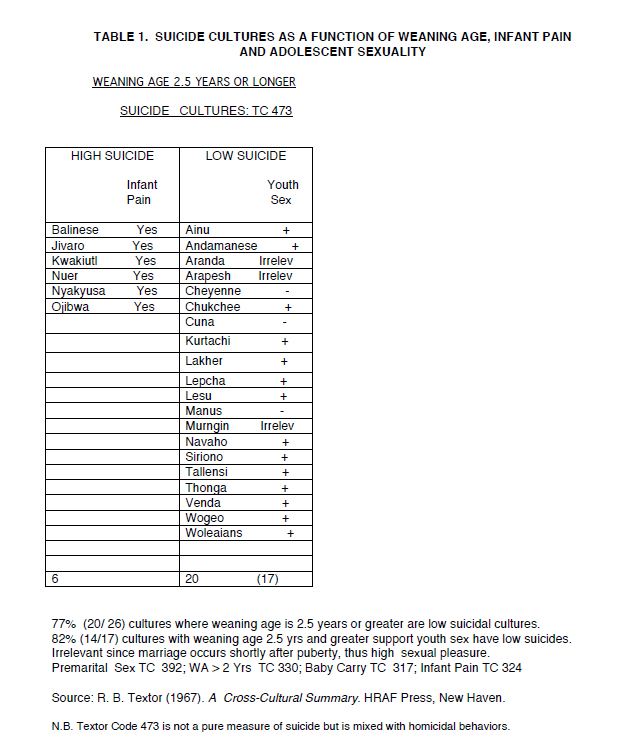
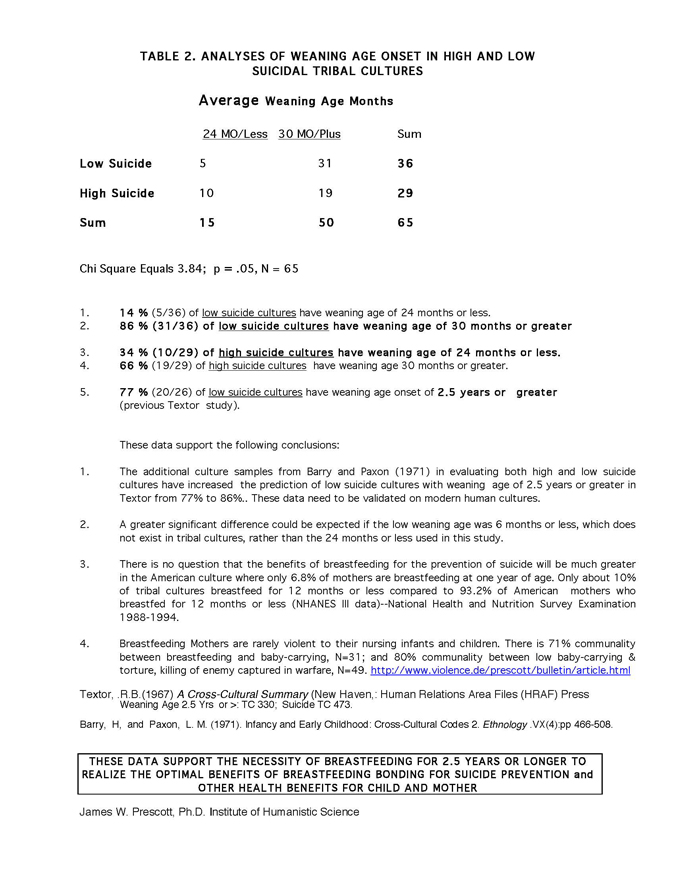
Table 3 presents the Social-Behavioral Characteristics of Cultures Where Weaning Age Is 2.5 Years Or Greater. Textor Code 330 (% Communality of Cultures)
All of these correlates are statistically significant. The salient statistically significant correlates reflect the positive affectional relationships in the culture including:
High Mother/Infant Contact Is Beyond Two Years
Infant Physical Affection Is High
Indulgence of Child Is High
Divorce Rate Is Low
Child Conflict Over Nurturing Behavior Is Low
N.B. The value of quantitative tribal cultural data is the lack of influence of communication technologies of modern cultures, viz radio, movies, TV computer games, etc.—the audio-visual sensory neocortical brain.

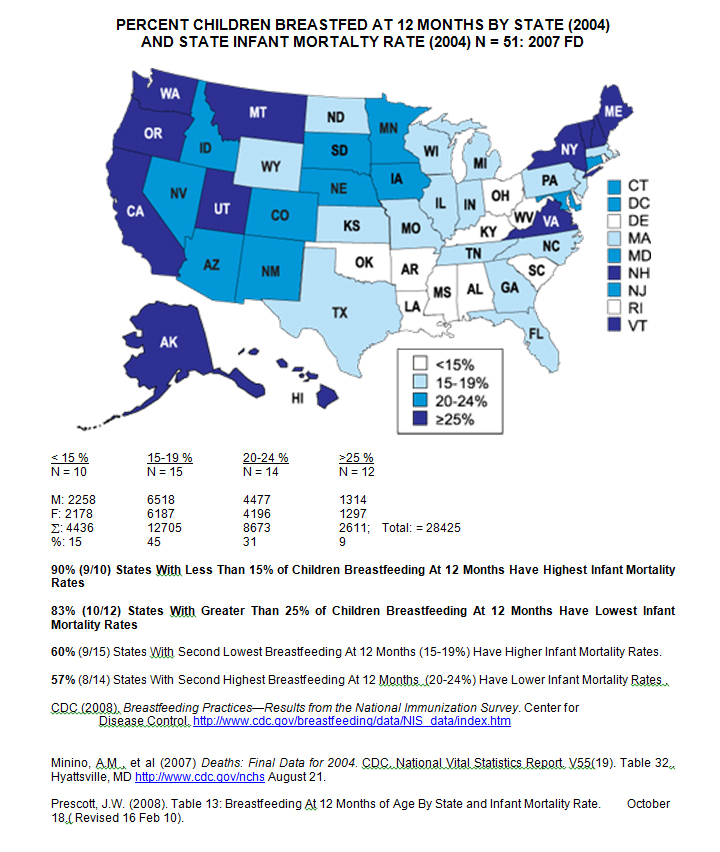
The Third National Health and Nutrition Examination Survey, 1988-94
For the 2,685 sample of 3-5 yr olds from NHANES III, (variable HYB5) – the following information is provided (Hedger, 2001).
For all children
9.6% were breastfeeding at 11 months 6.8% were breastfeeding at 12 months
2.7% were breastfed for 24 months or more, 1.0% was breastfed for 30 months or more.
For the children who were ever breastfed:
17.9% were breastfeeding at 11 months 12.7% were breastfeeding at 12 months
5.1% were breastfed 24 months or more 1.8% for 30 months or more.
The findings for all children where only 6.8% were breastfeeding at 12 months; 2.7% were breastfeeding at 24 months and 1% for 30 months or more indicates the crises that exists in America for compromised brain development of our infants and children and for the realization of peace, harmony and happiness.
In an article in the New York Times (8.2.10) by Nicholas Wade “Breast Milk Sugars Give Infants a Protective Coat”, he states: “A large part of human milk cannot be digested by babies and seems to have a purpose quite different from infant nutrition — that of influencing the composition of the bacteria in the infant’s gut”.
Dr David Mills, University of California, stated:
“Such findings have made the three researchers keenly aware that every component of milk probably has a special role. “It’s all there for a purpose, though we’re still figuring out what that purpose is,” Dr. Mills said. “So for God’s sake, please breast-feed.” http://www.nytimes.com/2010/08/03/science/03milk.html
Breastfeeding Bonding for “two years or greater” is essential for life: prevention of infant mortality, depression and suicide and many other health benefits for mother and child.
Human societies must support mothers being nurturing mothers and respect the emerging sexual development of children and youth, if sexual affectional and egalitarian hamonious relationships are to become a reality
http://www.violence.de/prescott/letters/WHO_Innocenti_Declaration.pdf
“Women are the mothers of humanity; do not let us ever forget that or underemphasize its importance. What mothers are to their children, so will man be to man” (pp. 247- 248); Ashley Montagu. The Natural Superiority of Women 1952.
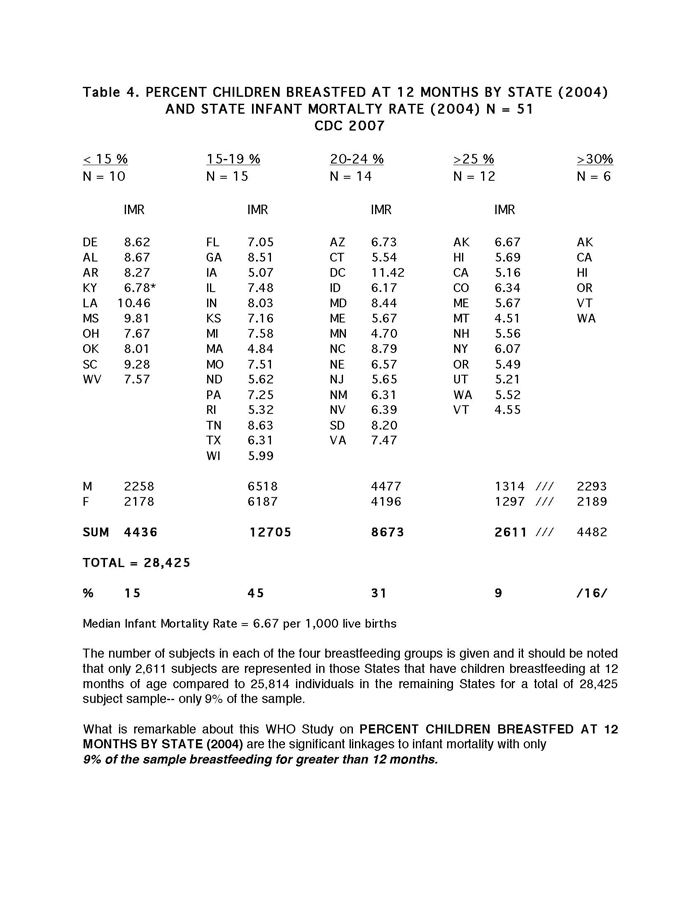
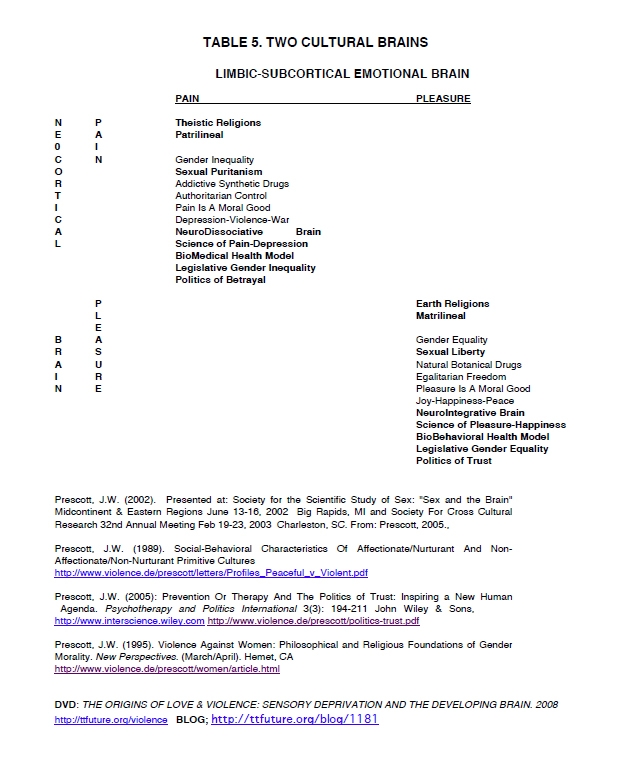
Prescott, J.W. (2002). Presented at: Society for the Scientific Study of Sex: “Sex and the Brain” Midcontinent & Eastern Regions June 13-16, 2002 Big Rapids, MI and Society For Cross Cultural Research 32nd Annual Meeting Feb 19-23, 2003 Charleston, SC. From: Prescott, 2005.,
Prescott, J.W. (1989). Social-Behavioral Characteristics Of Affectionate/Nurturant And Non-Affectionate/Non-Nurturant Primitive Cultures
http://www.violence.de/prescott/letters/Profiles_Peaceful_v_Violent.pdf
Prescott, J.W. (2005): Prevention Or Therapy And The Politics of Trust: Inspiring a New Human Agenda. Psychotherapy and Politics International 3(3): 194-211 John Wiley & Sons, http://www.interscience.wiley.com http://www.violence.de/prescott/politics-trust.pdf
Prescott, J.W. (1995). Violence Against Women: Philosophical and Religious Foundations of Gender Morality. New Perspectives. (March/April). Hemet, CA
http://www.violence.de/prescott/women/article.html
REFERENCES
Barry III, H. and Paxon, L.M. (1971). Infancy and Early Childhood: Cross-Cultural Codes 2. Ethnology X(4):466-508.
Dokecki, P.R. (1973). When the bough breaks…what will happen to baby. Review of: Rock-a-bye Baby. Time Life Films (Lothar Wolff, Ex. Prod.) Contemporary Psychology. 18:64.
http://www.violence.de
Prescott, J.W. Body Pleasure and the Origins of Violence. (1975) The Futurist April Reprinted: The Bulletin of The Atomic Scientists 1975: November.
http://www.violence.de/prescott/bulletin/article.html
Prescott, J.W. Phylogenetic and ontogenetic aspects of human affectional development.(1977). In: Progress In Sexology. Proceedings of the 1976 International Congress of Sexology. (R. Gemme & C.C. Wheeler, Eds.) New York: Plenum Press.
http://www.violence.de/prescott/pis/1977paper.pdf
Prescott, Ph.D. (1989): Sixteen Principles for Personal, Family and Global Peace
http://www.violence.de/prescott/letters/Sixteen_Principles.pdf
Prescott, J.W. (l990): Affectional bonding for the prevention of violent behaviors: Neurobiological, Psychological and Religious/Spiritual Determinants. In. Violent Behavior Vol. I: Assessment and Intervention. (L.J. Hertzberg, et. al.,Eds). PMA Publ. NY pp. 110-142.
http://www.violence.de/prescott/Violent_Behavior_1990.pdf
Prescott, J.W. (1996). The Origins of Human Love and Violence. Pre- and Perinatal Psychology Journal. 10(3):143-188. Spring. http://www.violence.de/prescott/pppj/article.html
Prescott, J.W. (2003). Our Two Cultural Brains: Neurointegrative and Neurodissociative.
http://www.violence.de/prescott/letters/Our_Two_Cultural_Brains.pdf
Prescott, J.W. (2005): Prevention Or Therapy And The Politics of Trust: Inspiring a New Human Agenda. Psychotherapy and Politics International . 3(3):194-211 John Wiley & Sons, http://www.interscience.wiley.com http://www.violence.de/prescott/politics-trust.pdf
Textor, R.B. (1967) A Cross-Cultural Summary. Human Relations Area Files. HRAF Press.
New Haven
James W. Prescott, Ph.D.
Institute of Humanistic Science
jprescott34@comcast.net
http://www.violence.de
http://www.montagunocircpetition.org
